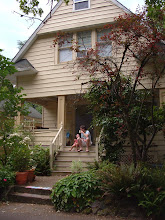K said it was something about the open stairwell, and W added that high ceilings both up and downstairs also made the house feel grown up. Admittedly, our "new" house (which is actually about 20 years older than our "old" house) is much bigger, in square footage as well as in what K described as stoutness. But I suggested that another thing made this house seem more grown up than our other one: the entry hall. Having a room reserved for entering a house seems incredibly mature and decadent.
K & W live in a little 1920s bungalow with attic stairs (rather than open stairs) and their second floor is typical for houses of this period: one large room tucked up tight under eaves and sided by kneewalls; their house is a lot like our former house, also a little 1920s bungalow. In fact, many of the people we know in Portland live in these types of bungalows because they make up the majority of the affordable housing stock on the eastside.
The American bungalow was, according to Diane Maddex in her book Bungalow Nation, conceived as a house that is "no bigger than it needs to be." Accordingly, bungalows were designed with open floor plans, including a combo dining room-living room and a front door that opened directly into the living room. Buh-bye, entry halls and ostentatious Victorian parlors. Hello, combined public spaces and direct, easy access between outside and inside.


Though I'm on board with the elegance, simplicity, and practicality of the bungalow style, I admit that one of the main reasons I fell in love with this old drafty fixer (called a farmhouse by some, an Old Portland Craftsman by others) was because of the entry hall with its open stairwell. There is something grand and generous about the room (cluttered though it may be), especially with light spilling in from the stairwell windows. But the room is also incredibly useful as a place to unload the gear and tools we use in the outside world: jackets, shoes, umbrellas, dog leashes, hats, gloves, bags. Yes, it feels terribly grown up to have a room for just this purpose.
Of course, we welcomed friends and family into all of our former dwellings--none of which had entry halls--with the same sense of generosity; as far as I know, not a single visitor later remarked, "Wow, that was a fun evening, but it would have been better if they'd had an entry hall in which to greet us." I think it's interesting how we emotionally respond to particular spaces. I'm sure some of this is steeped in collective nostalgia--the Norman Rockwell-esque image of guests arriving for Thanksgiving dinner and being greeted by an apron-clad mom in the entry hall. But this intuitive reading of space must also be rooted in something deeper.
Maybe Christopher Alexander is on to something when he emphasizes the importance of transitional spaces like the entry hall in his book A Pattern Language: "the time of arriving, or leaving, seems to swell with respect to the minutes which precede and follow it, and that in order to be congruent with the importance of the moment, the space too must follow suit and swell with respect to the immediate inside and the immediate outside of the building."
His description makes spaces sound alive, which perhaps they are when imbued with the energy and emotions--pleasure, enthusiasm, anticipation--that we carry with us.
His description makes spaces sound alive, which perhaps they are when imbued with the energy and emotions--pleasure, enthusiasm, anticipation--that we carry with us.




2 comments:
I miss the entry hall of the 1903 house I grew up in. I also miss the front porch. My current 1920s house is basically K&W's house -- a skimpy little porch, no entry hall, a second floor that's just a glorified attic. And what I don't like about the lack of porch and entry hall is that it feels too abrupt -- there's no transition between outside and inside, public and private. You need a porch and then an entry hall for a sense of leaving the wider world and coming, well, home.
I agree. Though Alexander can be a little touchy-feely, he's right when he talks about space and patterns. They narrate our lives in very real ways.
Post a Comment